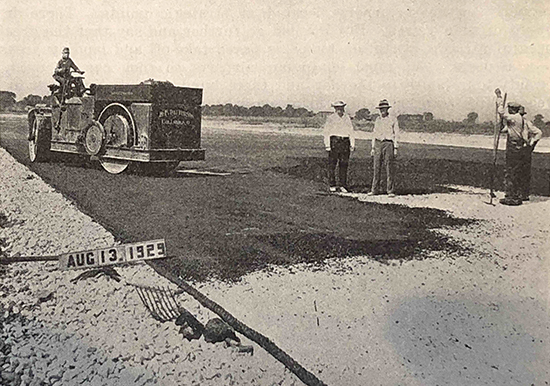
One of the earliest presentations on airfield paving in the Asphalt Institute’s (AI) archives appears to be in 1928 when Col H. H. Blee, Chief of the Airport Section, Aeronautics Branch, U.S. Department of Commerce spoke at the organizations’ co-sponsored 7th Annual Asphalt Conference in December.
During his presentation entitled “Airports and Airways”, Blee stated “the airplane has emerged from the chrysalis of doubt and uncertainty and has stretched forth its wings and taken off over the airway of success and now we are indeed standing on the threshold of the era of air transportation.”
The latest technologies being developed to aid flying and improve safety he mentioned were airfield lighting, radio beacons for navigation and double (parallel) runways to facilitate growing air traffic demands. Finally wrapping up his talk, he challenged those in attendance, “calling for sound engineering…we are currently building air transports that weigh 15,000 pounds, in a few years we will be building air transports that weigh 30,000 to 40,000 pounds or more.”
October 31, 1929
At the 8th Annual Asphalt Conference, R. H. Simpson, City Engineer for the city of Columbus, Ohio, reported that the newly opened Port Columbus Airport was paved with a 1.5 inches asphaltic concrete on 90,200 square yards in 13 days.
November 20, 1930
With the establishment of the Civil Aeronautics Administration (CAA), the Asphalt Institute was asked to conduct training on asphalt paving for the construction of airfields.
September 1, 1940
Through AI’s Managing Director W.R. Macatee’s promotional efforts, the Washington National Airport (Reagan) opened with one million square yards of asphalt paving.
December 5, 1940
At the 19th Annual Asphalt Conference, in a presentation entitled “Airports and National Defense”, A.B. McMullen, Chief of the airport section of the CAA commented “There no longer can be any doubt that a nation’s best insurance against aggression is superiority of airpower. As paving technologists, you are well aware that our great projected Air Force cannot do the job of defending this country if, at some critical hour, it is stuck in the mud.”
At the time there were only 1,857 civil airports, and of this total, less than two percent could handle the heaviest and fastest military aircraft in all weather. McMullen then goes on to forecast the need for a system of 4,000 airfields over the next six years to handle both the growth in aviation as well as the military buildup.
As for the size of aircraft, McMullen said “airplane engineers feel that under conditions of present airline patronage, planes much in excess of the present-day maximum of 65,000 pounds will be found uneconomical to operate. However, there’s no economic restriction on the size of military planes, in the CAA we are envisioning the necessity of building runways which 10 years hence will be called upon to handle maximum gross loads of 300,000 pounds at the largest airports.”
When the Army Corp of Engineers asked AI to provide expertise about rock and asphalt for heavy-duty pavements, AI engineer O.J. Porter proposed the design that would allow the new B-29 bomber to properly operate.
Present day
Since 2001, AI has partnered annually with the Federal Aviation Administration (FAA) to conduct the three-day Airport Pavement Technical Workshop (APTW). This workshop provides the most up-to-date information for those designing, constructing and managing asphalt airport pavements.
In 2013, 84 years after its original construct, Port Columbus opened its third full-depth asphalt runway when RW 10R-28L became operational.
In 2018, AI introduced the 1.5-day Airfield Paving Clinic (APC). The APC provides guidance on constructing asphalt pavements following FAA’s recently released Advisory Circular 150/5370-10H and specifically the P-401 asphalt specification.
2019 marks the 25th consecutive year that AI’s Director of Engineering, Dr. Mark Buncher, has served as chair of the Tri-service’s Airfield Asphalt User-Producer Group (AAUPG). The AAUPG meets every year during the Transportation Research Board’s Annual Meeting in Washington, D.C. to review the military’s shared Unified Facilities Guide Specifications (UFGS) pertaining to asphalt paving, as well as to discuss the future specification changes.
AI continues to support the FAA and the U.S. military through technical consultation on issues that arise, new technologies to be implemented and changes being considered for specification updates.
Jones is an Asphalt Institute Senior Regional Engineer based in Ohio.













